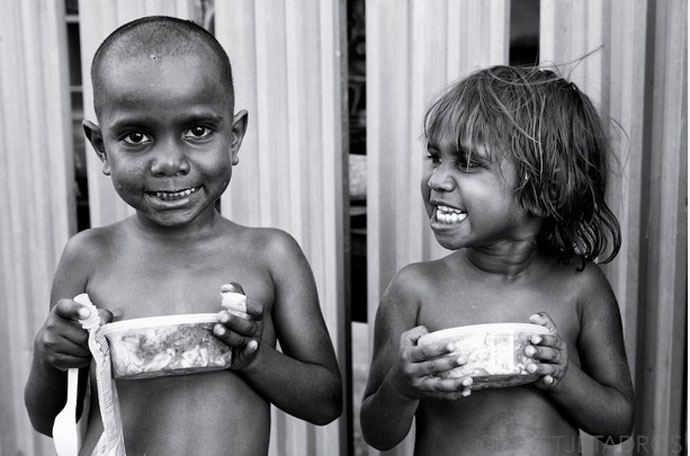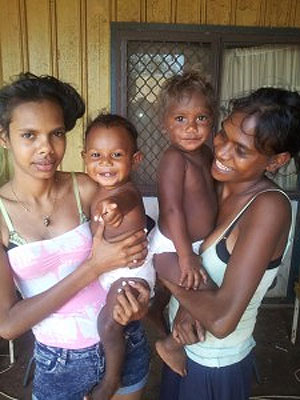Suicide is heading to a humanitarian crisis – it is a leading cause of death
The suicide rate for young people in First Nation communities is of catastrophic proportions, but there is so little discussion and attention given to it by government's, the media and mainstream Australia

Marjorie and Kitana from Kennedy Hill, Broome, WA
(Photo: Ingetje Tadros)
Gerry Georgatos The Stringer 28 February 2015
According to the World Health Organisation Global Health Estimates, there were reportedly 804,000 deaths by suicide in 2012. In my estimates, if we are to factor in unreported and unclassified suicides the suicide toll is more than likely at least double the report numbers. The highest suicide trends are disproportionately prevalent in western nations, in developed nations, in nations with relatively recent colonial oppressor histories where today the descendants of their First Peoples are discriminated minorities.
An aggregation of only high-income nations comprising only 18 per cent of the world’s total population are responsible for one quarter of the world’s reported suicides – nearly 200,000 deaths by suicide. Suicide in high income nations takes on average three times as many males as it does females. But in poor nations this ratio is less, with less than 2 males suiciding for every female life lost to suicide. In general, suicide rates are highest in the 70 years and older age categories, and suicide rates are lowest among those aged less than 16 years of age. But if in the high-income nations with colonial oppressor histories when we disaggregate statistical narratives to the descendants of their First Peoples we find that they have much higher suicide trends than the rest of the population. The majority of their suicides are below the age of 35 years, with the highest risk category of those aged in their twenties.

(Photo: Ingetje Tadros)
Globally, suicides constitute 56 per cent of all violent deaths. In the aggregation of high-income nations, 81 per cent of all violent deaths are by suicide. Suicide is evidencing itself in high-income nations as demonstrative that social cohesion is fallacious. There is much mention in the media of ‘violence’, especially of gun-related violence, drug-related violence, of the social fabric threatened by such various violence culminating in death, but the media fails to disaggregate and discuss the leading cause of lethal violence – suicide. In these nations where suicide is the leading cause of violent deaths, suicide prevention should be prioritised in the nation’s social agenda.
In order to develop a comprehensive suicide prevention strategy we must explore why life stresses in some cultural settings can culminate in high rates of reported depressions, self-harm and suicide while in other settings they do not culminate in high rates of reported depressions, self-harm and suicide.
However we also need to look at high-income nations with colonial oppressor histories. We need to look at the depression rates, self-harm and suicide rates among the descendants of their First Peoples, who in many of these high-income nations have now become minorities. The majority of the world’s high-income nations have minorities of First Peoples with among the world’s highest depression, self-harm and suicide rates. Oppression continues as an ongoing trauma manifest from the effects of racialised marginalisation. Identity, historical and contemporary, has become a liability for far too many – with constant attacks on their identity – on who they are or should be. These attacks are made on a daily basis by politicians, journalists, social commentators, people in general. Race, racialization, racism become troubling issues – psychologically and emotionally abusive washes of sweeping generalisations, prejudices, biases.
For every suicide it is estimated there are 30 to 40 suicide attempts – an obvious significant impact on communities. According to the many research bodies, a suicide attempt is a powerful predictor. Individuals who have made suicide attempts are at higher risk of suicide than those who do not have such a history. This predictor can measure community distress. In terms of preventing suicides, immediate and longer term follow up care are critical for those who have attempted suicide and for those who have admitted to suicidal ideation. It is a dangerous myth for anyone to suggest that anyone who talks about taking their life is not serious. In reality they are screaming for help. People need people – this must always be understood as an imperative if there is to be genuine suicide prevention.
Each year in Australia, tens of thousands are admitted to hospital for reported self-harm. This should be seen as a high-needs group and while hospitalised an opportunity for more to be done psychosocially to help them.
It is a myth to presume that the majority of suicides occur without warning. In fact, the majority of suicides have a significant period preceding them where there have been warning signs – verbal and/or behavioural. People need people – and these warning signs should never be dismissed. Prevention strategies must include response systems and task forces who are accessible 24/7 to assist people – in reality these response systems should be set up in ways that if necessary people can be assisted psychosocially and empowered, from a very young age and to as old as. Governments should pay attention in many different ways to warning signs – where these warnings bespeak of a troubled community, regions, clusters, contagion effect, then socioeconomics factors may need to be addressed, or the empowerment of communities long denied this natural right in terms of their right to manage their own affairs and the right to advance their unfolding within their own terms.
Suicide is heading to a humanitarian crisis, but there is very little discussion and attention given to it, despite it being a leading cause of death. But for many minorities it is already a humanitarian crisis – of catastrophic proportions.
The Stringer:
Suicides are preventable – here is what we must begin to do | The Stringer
The extensiveness of Aboriginal & Torres Strait Islander suicides – 1 in 20 | The Stringer
Preventing suicide – “no greater legacy” | The Stringer
Understanding Australia’s suicide crises
Suicides, high among overseas born and second generation Australians
Child suicidal ideation on the increase
It is racism killing our people – suicides born of racism
Kimberley suicide rate – one of the world’s highest – Yiriman is the way to go
My Country – But look how I am forced to live
What will it take to end Aboriginal disadvantage, the inequalities and the various crises?
What sort of Australia is this? Seven homeless children in an asbestos slum
Six homeless children fighting for a better tomorrow
Quality of life for Australians 2nd only to Norway but for Aboriginal Peoples 122nd
Dumbartung convenes suicide crisis summit
Suicide attempts among women on the rise
Australia’s Aboriginal children detained at the world’s highest rates
Culture should not be denied – change needs unfolding, not impost
Everyone in the Territory doing well, except for Aboriginal Peoples
Australia’s Aboriginal children, the world’s highest suicide rate
Wes Morris slams government suicide prevention programs
How many more suicides will it take? How many more deaths?
Hopelessness in suicide riddled communities
More government neglect of Aboriginal children
In identity lay the answers – ATSI suicides
$25.4 billion spent on Aboriginal disadvantage is a lie
Beagle Bay to State Parliament – Farrer speaks out on suicides
Government to address Aboriginal suicides
996 Aboriginal deaths by suicide – another shameful Australian record
996 deaths by suicide – one in 24 die by suicide
Australia’s Aboriginal suicide epidemic – whose child will be the next to die?
77 Aboriginal suicides in South Australia alone
Kimberley’s Aboriginal peoples old at 45 years
Australia, the mother of all jailers of Aboriginal people
Tumult of death – 400 suicides in last three years
30 suicides in the last three months as we wait for promises to be kept
Suicide crisis – genocidal numbers
Suicide crisis – from tragic to catastrophic
Suicide crisis needs real funding and actions
Hundreds more will suicide if we wait for 2015
Nothing will be done about suicides crisis
Elders across Australia say governments need to listen to them on how to address youth suicide
Suicides – western society and ancient cultures clash
If we are serious about suicide prevention
Australia’s suicide crisis should not be played down – the media must highlight it
From my father’s death bed to the must-do to end the suicides
Governments promise on ending suicides must come good now
More confirmation of what everyone knows, was suicide prevention inadequate
The must-do need to listen and trust if suicides crisis is to end
Working together – mental health and suicide prevention roundtable
Break the taboo around suicides, we reduce suicides
Suicide crises born of Australia’s inhumanity
Suicides crisis linked to incarceration
Wes Morris urges funding for cultural methodologies
The betrayal of our children – the Northern Territory
New project offers hope to reduce Aboriginal and Torres Strait Islander suicides
Depression and suicide prevention must be top of the agenda this century
World Suicide Prevention Day – suicide takes more lives than war
Western Australia – 1 in 13 in a jail, a bullshit state of affairs
Yiriman saving lives in the midst of the Kimberley’s suicide crises
The smaller a community, the less likely a suicide
Overcoming disadvantage report shows disadvantage not overcome
600 Black deaths in custody by 2025 – jail numbers to soar
Get out of the way – Aboriginal suicide rates will drop
A nation shamed when the solution for its children is homelessness
Christmas, a period of vulnerability for many
Stop peddling lies $30 billion spent on Indigenous disadvantage is a lie
To end our trauma government must stop the assault on our people and our culture
In Australia there is the Aboriginal rights struggle
Kirstie Parker, Mick Gooda say enough of fine words – close the gap a big fat lie
Highest child removal rates in the world worse than Stolen Generations
Other media:
A nation shamed when child sees suicide as the solution
Families urged to look after each other as suicide rates soar
Response to rash of suicides in remote WA regions
ABC 7:30 Report – Deaths in custody and jail rates
Radio:

